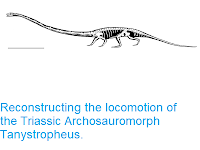Archosauromorphs, defined as everything more closely related to
Dinosaurs and Crocodiles than to Lepidosaurs (Lizards, Snakes and Sphenodon,
flourished in the aftermath of the End Permian Extinction, becoming the
dominant Vertebrates in most terrestrial ecosystems. They have suffered
heavily in each of the subsequent mass extinction events, particularly
the End Triassic and End Cretaceous, but each time recovered, with over
10 000 species still alive today (mostly Birds). Almost all post-Triassic Archosauromorphs belomg to three highly successful groups, the Testudines (Turtles and Tortoises), the Crocodylomorphs, and the Dinosaurs (including the Birds), however, in the Triassic a much more diverse range of these animals was present.
In a paper published in the journal Nature Communications on 23 March 2018, Adam Pritchard of the Department of Geology and Geophysics at Yale University, Jacques Gauthier, also of the Department of Geology and Geophysics at Yale University, and of the Yale Peabody Museum of Natural History, Michael Hanson, again of the Department of Geology and Geophysics at Yale University, Gabriel Bever of the Center for Functional Anatomy and Evolution at Johns Hopkins University, and Bhart-Anjan Bhullar, once again of the Department of Geology and Geophysics at Yale University, and of the Yale Peabody Museum of Natural History, describe a new species of Archosauromoph from the Late Triassic New Haven Arkose of Connecticut.
The new species is named Colobops noviportensis, where 'Colobops' means 'short-snout', and 'noviportensis' means 'from Newhaven'. The species is described from a nearly complete cranium and coronoid process of right mandible, lacking tooth-bearing portions of premaxillae, maxillae, palate, and mandible, preserved largely within a sandstone matrix and μCT scanned at the Laboratory of Integrative Science’s Center for Nanoscale Systems at Harvard University.
Reconstructed skull of Colobops noviportensis. Three-dimensional volume rendering of the skull produced in VG Studio Max 3.0 in (a) dorsal, (b) ventral, (c) left lateral, and (d) anterior views. Gray portions indicate portions of the skull of uncertain homology. Scale bar equal to 1 cm. Abbreviations: cp, coronoid process; fo, fontanelle; pf, parietal foramen; sc, sagittal crest. Pritchard et al. (2018).
The skull of Colobops noviportensis is estimated to have been only 2.5 cm in length, providing a valuable insight into smaller Triassic Archosauromorphs, which are less well understood than their larger relatives. The precise affinities of Colobops noviportensis are uncertain, but it appears likely that it was a Rhynchosaur, an early group of Archosauromorphs closely related to the Archosauroformes, the group which includes Dinosaurs and Crocodylomorphs. This species was relatively short-snouted, and appears to have had a powerful bite.
See also...





